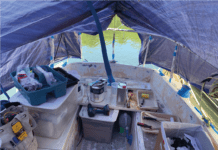Rigger Glenn Mooney of Yacht Riggers in St. Petersburg, Florida has no choice but to be organized. A veteran rigger with more than three decades of experience, Mooney works out of two shipping containers joined end-to-end at Salt Creek Marina. The setup suits him just fine. The walls are neatly arranged with the hardware, tools, and accessories that his job requires, and two long workbenches line either side.
I visited Mooney’s shop earlier this year on a mission to replace the vinyl coated lifelines on my Yankee 30 Opal with bare 1 x 19 lifelines. The moment I stepped inside, I had the strange feeling that I’d been there before–but it took a while to figure out why. If you are also looking at replacing your lifelines, here are few of our many reports on the topic that guided my own project.
Seven years ago, safety guru Ralph Naranjo reported on a test carried out at the US Naval Academy that found that pushpits and pulpits were a weak link in the average lifeline system (see PS September 2012, “USNA Lifeline Test Reveals Weak Spots.”). In other words, don’t let your lifeline project stop at the wire.
Former editor Nick Nicholson’s report on lifelines provides a excellent overview of what a reliable lifeline installation should look like (see PS September 2002, “Offshore Log: Check Your Lifelines, Save Your Life”).
The popularity of Dyneema and other high molecular weight polyethylene ropes (HMWPE) has transformed the way we think about rigging, especially lifelines. My blog piece last summer covers the pros and cons of switching to fiber and includes links to several relevant reports (see Inside PS “Check Chafe Before Switching to Fiber Lifelines”).
One problem with most lifelines is that they are below an upright body’s center of gravity. This is why keeping low when moving about is so essential. In 2016, Technical Editor Drew Frye discussed how he uses chest-high lifelines, which many offshore sailors install before each offshore voyage (see PS July 2016, “Raising the Bar on Lifelines”).
Those who miss the humor and encyclopedic knowledge of the late great Practical Sailor editor Dale Nouse will enjoy his short and sweet report on C.S. Johnson’s lifeline netting. The report, like just about every one Dale produced, follows a circuitous route—in this case from the looms of ancient Mexico to the back porch of your local Tiki bar—to arrive at the topic at hand: colored lifeline nettings (see PS September 2005, “Lifeline Netting”).
When Mooney finally handed me my new lifelines, which fit perfectly stem to stern, I realized why his workshop felt so familiar. Unlike me, Dale was a fastidious type, and his tidy basement workshop reflected this approach to life. Labeled ropes hung from the ceiling, the pegboard walls held neatly arranged tools for every job, and the folders in his file drawers (remember those?) were precisely categorized by topic.
The nice thing about a new boat is that—like moving to a new town—you get a chance to reinvent yourself. As I move forward with Opal’s refit, I vow I’ll do things differently—smarter, simpler, better. Being better organized is high on my list of goals.
With only 30 feet to work with, I have no other choice.










































